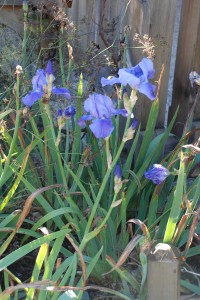Gardeners who desire more flowering from garden iris (Iris spp.) should be planting re-blooming types. Some cultivars may re-bloom up to three times in one growing season. The re-blooming trait is found both in bearded and beardless irises (I. germanica).
Re-bloomers need to be well established for one year, sometimes two, to bloom multi-seasonly. Some re-bloomers are sporadic, and a short list of dependable varieties is included below.
Information on growing tall bearded iris is found in an earlier blog (April 1, 2012). Re-bloomers multiply faster than one-time bloomers, and need to be divided every two to three years to avoid overcrowding. Some cultivars need to be well established before they re-bloom; lift and divide only part of the clump and leave the remaining portion undisturbed to re-bloom. Also, clipping off the foliage too early in late summer reduces re-bloom potential.
Re-bloomers are heavy feeders and benefit from two feedings, once in the spring, nearing the end of the regular flowering period, and a second time in mid- August, the start of the 2nd or 3 rd re-blooming period. Fertilize with a low nitrogen analysis, such as 5-10-5. Re-blooming cultivars need frequent irrigation during dry summer periods compared to standard irises.
A baker’s dozen cultivars include: Best Bet, Bountiful Harvest, Clarence, Hemstiched, Immortality, Jennifer Rebecca, Mother Earth, Pagan Goddess, Pagan Dance, Autumn Tryst, Champagne Elegance, Orange Harvest, Rosalie Figge.


 Posted in
Posted in 
